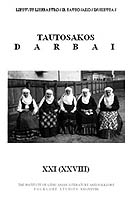Tautosakos darbai
Folklore studies
Publishing House: Lietuvių literatūros ir tautosakos institutas
Subject(s): Social Sciences
Frequency: 2 issues
Print ISSN: 1392-2831
Status: Later issues not available
- 2004
- 2005
- 2006
- Issue No. 27
- Issue No. 28
- Issue No. 29
- Issue No. 30
- Issue No. 31
- Issue No. 32
Articles list
{{ article.TitleOriginalLanguage }}
{{ article.TitleOriginalLanguage }}
({{ article.TitleEnglish }})
- Publication: {{ article.Publisher }} ({{ article.Issue }})
- Author(s): {{ article.Authors }}
- Contributor(s): {{ article.Contributors }}
- Language: {{ article.Language }}
- Subject(s): {{ article.Subjects }}
- Issue: {{ article.Issue }}
- Page Range: {{ article.PageRange }}
- No. of Pages: {{ article.NumberOfPages }}
- Keywords: {{ article.Keywords }}
- Summary/Abstract: {{ article.SummaryAbstract }}
- Price: {{ common.currency(article.Price) }}
Short Description
The Department is responsible for the amassment, arrangement, preservation and dissemination of folklore; it is also engaged in the process of the publication of fundamental scientific collections and sound records. The valuable funds of the Lithuanian Society of Science (1907–1940) and the Lithuanian Folklore Archives (1935–1939) with over half a million of recorded pieces of folklore bequeathed to the Institute, at present house the total of more than 1.5 million folklore works: song texts and songs with their melodies, folk tales, legends and other tales, proverbs, riddles as well as exorcisms, beliefs, ethnographic descriptions, folk medicine and etc. The Archives of Lithuanian folklore is the biggest folklore depository in Lithuania, possessing quite a few audio-visual materials and aiming at the collection of the remainder of folklore. The very first sound recordings made on wax cylinders date back to the year 1908, those recorded on shellac discs and on magnetic tapes are from 1935 and 1958 respectively. The first photographs were received from Balys Buračas in 1934. This unique material serves as a specific source for folklore research. The Department has developed the program “The Database of Lithuanian Folklore”. Together with other departments of the Institute the Department of Folklore Archives takes part in the general project “Folklore in the Modern Society: Processes of Development and Spread”. Since 2001 the long-term “Preservation and Publishing Program of Sound Recordings” is in progress. The Department staff proceeds with the amassment of the material, which reflects the folklore of the past, strive to preserve it and investigate the tendencies of folklore change. Field studies and individual field trips are organized to test and identify divergent folklore phenomena by means of modern technological equipment, e.g. computers, digital audio and video recording systems. The copies of valuable or frequently used manuscript and sound records collections are made. Catalogues are supplemented by newly acquired folklore material. The manuscripts of Lithuanian folklore heritage of the 18th–20th centuries and the earlier published materials are put out constantly with a view of their importance as the essential source not only for folklore studies but also for ethnography, linguistics and other fields of humanitarian science as well as for cultural society at large. In 1998, an eminent folklorist Jurgis Dovydaitis presented his personal archive, containing 350 notebooks, 45 subject collections, 1243 magnetic tapes, with a total of more than 100 000 pieces of different folklore works, 800 photo films and a sheaf of melodies transcribed by Bronius Uginčius to depository of the Folklore Archives. Dr. Rūta Žarskienė is Head of Department and is aided by 2 doctors of science, 1 scientific worker, 4 assistants, 1 senior laboratory assistants, 3 editors and 1 layout designer.

